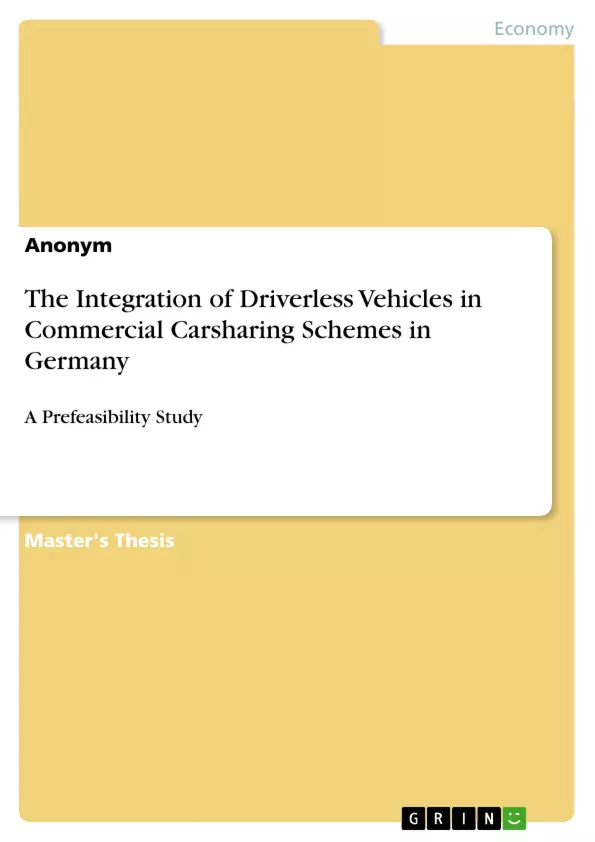The prefeasibility study at hand proposes to integrate driverless vehicles in commercial carsharing schemes in Germany. It finds indications that carsharing has the potential to become a significant mode of transport because it responds to social and business change. On the other hand, the study shows that it is the human component in traffic causing the majority of accidents, which is why driverless vehicles are expected to reduce traffic accidents and improve road safety. By making use of the business management tools SWOT analysis and an ad hoc STEPLED analysis, the study conducts a micro-environmental and macro-environmental analysis of the German carmakers BMW and Daimler in regard to the proposed concept. The main finding is that the technology is generally expected to be marketable within the next two decades, if not much earlier. It can be expected that customers will accept driverless vehicle technologies and that many new target groups could be reached by the realisation of the concept. Carmakers should benefit from this potential and might be able to offset possible losses in their core business. The analysis does also show, however, that the current legislation poses several obstacles and might, if unchanged, delay the introduction of driverless vehicle technologies. It is recommended for carmakers to become active and start a public debate similar to the one in the United States. Moreover, it is recommended to collaborate closely with other mobility providers in order to avoid lobbying against the idea.
Inhaltsverzeichnis (Table of Contents)
- Introduction
- Overview
- Definitions
- Structure of the Study
- Rationale
- Case Study: Germany
- Aim and Objectives
- Methodology
- Limitations
- Part 1: Carsharing
- Introduction
- Background
- Social and Business Change regarding Mobility
- From "Generation Golf" to "Generation Hire Car"
- From Carmaker to Mobility Provider
- Sustainability Concerns
- Carsharing as a Response to Social Change
- Generation Hire Car
- Carmaker or Mobility Provider
- Sustainability Concerns
- Limitations of Carsharing
- Parking
- Availability
- Part 2: Driverless Vehicles
- Introduction
- Background
- Social Issue Traffic Accidents
- Background
- The Role of the Driver in Car-related Traffic Accidents
- Traffic Accidents in Germany
- Economic Costs of Traffic Accidents
- Automation in Passenger Vehicles as a Response to Traffic Accidents
- Driver Assistance Systems
- Advanced Driver Assistance Systems
- Car Drivers, Customers, and Advanced Driver Assistant Systems
- Fully-Automated Vehicles
- Part 3: Prefeasibility Study
- Introduction
- The Concept
- Micro-Environmental Analysis: SWOT
- Strengths
- Weaknesses
- Opportunities
- Threats
- Macro-Environmental Analysis: STEPLED
- Society
- Technology
- Environment
- Politics
- Legislation
- Ethics
- Demographics
Zielsetzung und Themenschwerpunkte (Objectives and Key Themes)
The dissertation aims to analyze the feasibility of integrating driverless vehicles into commercial carsharing schemes in Germany. The study explores the potential of carsharing as a significant mode of transport, considering its response to social and business changes. Additionally, it examines the role of human error in traffic accidents and the potential of driverless vehicles to improve road safety. The analysis utilizes SWOT and STEPLED frameworks to assess the micro- and macro-environment of German carmakers BMW and Daimler in relation to the proposed concept. The key themes of the dissertation include:- Carsharing as a response to social and business changes
- Driverless vehicles as a solution to traffic accidents
- Technological advancements in automated driving systems
- Market feasibility of driverless vehicle technologies
- Regulatory and ethical implications of driverless vehicle integration
Zusammenfassung der Kapitel (Chapter Summaries)
The introduction provides an overview of the dissertation, including definitions, the study's structure, and the rationale for the research. It presents the case study of Germany and outlines the aim, objectives, methodology, and limitations of the study. Part 1 focuses on carsharing, exploring its background, social and business changes related to mobility, and its role as a response to these changes. This section also discusses the limitations of carsharing, including parking and availability issues. Part 2 examines driverless vehicles, outlining their background, the social issue of traffic accidents, and automation in passenger vehicles as a solution. The chapter delves into driver assistance systems, advanced driver assistance systems, and the perspectives of drivers and customers on these technologies. Finally, it discusses the potential of fully-automated vehicles. Part 3 presents a prefeasibility study, outlining the concept of integrating driverless vehicles in carsharing schemes. It conducts a micro-environmental analysis using SWOT and a macro-environmental analysis using STEPLED to evaluate the strengths, weaknesses, opportunities, threats, social, technological, environmental, political, legal, ethical, and demographic factors surrounding the concept.Schlüsselwörter (Keywords)
The main keywords and focus topics of this dissertation include driverless vehicles, carsharing, traffic accidents, road safety, automation, mobility, sustainability, SWOT analysis, STEPLED analysis, Germany, BMW, Daimler, legislation, ethics, and market feasibility. These terms represent the core concepts and research areas explored in the study, highlighting the integration of driverless vehicles within the context of commercial carsharing schemes and the various factors influencing its potential implementation.- Arbeit zitieren
- Anonym (Autor:in), 2012, The Integration of Driverless Vehicles in Commercial Carsharing Schemes in Germany, München, GRIN Verlag, https://www.grin.com/document/209818



